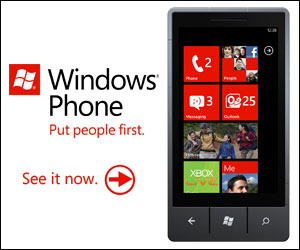REDMOND, Wash. — Oct. 11, 2010 — Smartphones have changed how we interact with one another. As a society, we’ve become addicted to our phones and the way they can help us stay connected — but as a result, we’re spending more time heads-down with our phones, to the point that we become unaware of what’s happening around us.
With the launch of Windows Phone 7, Microsoft has planned advertising that pokes fun at the awkward moments our addiction to our phones can create (See below and click here to see two of the ads.).
To learn more about the campaign strategy, Microsoft News Center spoke with Todd Peters, corporate vice president of Microsoft’s Mobile Communications Marketing Group.
Microsoft News Center: This is definitely a big launch for Microsoft. What should people know about Windows Phone 7?
Todd Peters: We love smartphones, and as a culture we love smartphones. But for all their success, Microsoft thinks there is a better smartphone experience. We noticed people going through their day with their heads down, constantly opening and closing applications, sorting, texting and searching for things. By designing a better way to organize all that information Windows Phone 7 helps people get to the stuff that is most important to them — easier and faster.

Microsoft News Center: What principles guided the creation of the ad campaign?
Peters: First off, the smartphone marketplace is cluttered, so it was critical that we tie the campaign to what we think of as the unique value proposition of Windows Phone 7. Secondly, the campaign had to break through the clutter and be different from any kind of advertising in the smartphone category. Finally, it had to connect with people on an emotional level.
With that in mind, the campaign is built on a consumer insight that we believe will really resonate with people: as a society we’re spending more time heads-down with our phones than we are interacting with the people we’re sitting right in front of. When people see the ads for the first time, it’s amazing how much self-recognition there is — that sense of “I have totally done that.” One of the core principles that guided us was that we wanted to start a conversation about how we could all benefit from a change in behavior and a different kind of phone experience.
Microsoft News Center: The campaign approach is interesting — some might say counterintuitive. How did you decide on this direction?
Peters: This approach is deeply rooted in the Windows Phone 7 experience and how we designed features like Live Tiles to give consumers information at a glance. At the same time, we were observing this “head in phone” behavior in our daily lives and saw an opportunity to bring the two ideas together. Capturing moments of bad cell phone behavior provided a perfect way to drive awareness of the benefits of the phone in a way that most people can relate to.

Todd Peters, corporate vice president, Mobile Communications Marketing Group, Microsoft.
Microsoft News Center: And taking a humorous, disarming approach will help engage the audience?
Peters: Correct. I don’t know anyone with a smartphone who will see these ads and not recognize a behavior in themselves or someone they know. We see this commentary as becoming very mainstream, seeing how smartphones have changed how we interact with one another. What we’re saying is “You’re not a bad person. We just think you have a poorly designed phone. Now take a look, consider us, and we’ll show you how we’re different.”
Microsoft News Center: So how is Windows Phone 7 different — and how will it change our behavior?
Peters: Fundamentally, we think that smart design will help people get information faster and easier. It’s the only phone with dynamic Live Tiles that let you quickly see everything you care about on your start screen. One glance tells you what’s going on now, what’s happening next and what you’ve missed. Another great example is how easy it is to take and share pictures
With the built-in camera button you can snap a photo even when your phone is locked, so you don’t miss a moment fumbling with your phone. One more click and you can send to friends or post to Facebook.
Microsoft News Center: When and where will the ads roll out? When can people expect to see them?

A still image from the Windows Phone 7 “Season of the Witch” television commercial that looks at the mayhem created when people become so immersed in their phones that they stop paying attention to what’s going on around them.
Peters: Unfortunately, early versions of some of the ads have already leaked onto YouTube, but the final ads will start rolling out first in Europe starting Oct. 12 and airing in the United States on Oct. 25. We have a total of eight ads, with each playing a slightly different role. Two of the ads were designed to be really disruptive, break through the clutter and let people know something new is coming.
We’ll quickly follow that up with six 30-second TV spots about the specific experiences that Windows Phone 7 enables: photos, People Hub, Xbox LIVE, Bing and two for the Start screen.
We’re going to have the biggest TV marketing campaign in the history of the mobile business, with the ads running on shows such as “Hawaii Five-0,” “Bones” and “Saturday Night Live,” as well as late-night talk shows. The holiday season is coming and the ads will be running frequently. If you don’t see them, then we’re not doing our jobs.
Microsoft News Center: What about social media?
Peters: Social media’s important, but television advertising is how smartphone brands are typically built. We’re complementing our broadcast strategy with a digital strategy that includes a Facebook application that allows you to populate a template of the Windows Phone 7 with real content pulled from your Facebook profile. It’s a great way to really personalize the experience and bring it to life for people.
In addition, we’ll create a tab on Facebook where people can engage in dialogue with us and post their own observations of bad phone behavior; we call these “Really?” moments.
These are a few examples of the investments we’re making across Twitter, YouTube, MySpace and the usual social networking sites.




